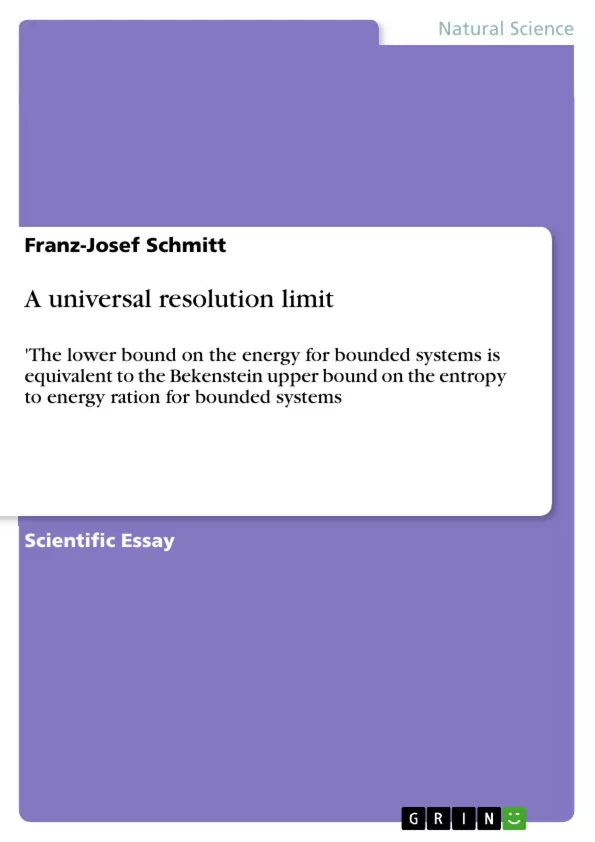Several approaches can be used to proof the
assumption that an universal upper bound on the entropy to
energy ratio (S/E) exists in bounded systems. In 1981 Jacob
D. Bekenstein published his findings that S/E is limited by
the “effective radius” of the system and mentioned various
approaches to derive S/E employing quantum statistics or
thermodynamics.
It can be shown that similar results are obtained considering
the energetic difference of longitudinal eigenmodes inside a
closed cavity like it was done by Max Planck in 1900 to
derive the correct formula for the spectral distribution of the
black-body radiation. Considering an information
theoretical approach this derivation suggests that the
variance of an expectation value D<O> is the same like a
variance of the probability D<p> for measuring O :
D<O> = D<p> * <O> . Implications of these findings are shortly
discussed.
Inhaltsverzeichnis (Table of Contents)
- Introduction
- The cavity as a measurement device
- Quantization and Uncertainty
- The energy-time uncertainty
- The general uncertainty of probability measurements in bounded systems
- Discussion
- Conclusion and further remarks
- Acknowledgements
- References
Zielsetzung und Themenschwerpunkte (Objectives and Key Themes)
This paper explores the concept of an universal upper bound on the entropy to energy ratio (S/E) in bounded systems, first proposed by Jacob D. Bekenstein in 1981. It examines the relationship between this bound and Heisenberg's uncertainty principle, as well as the implications for probability measurements in quantum systems.
- The Bekenstein limit on the entropy to energy ratio in bounded systems
- The role of quantization in bounding energy and uncertainty in closed cavities
- The connection between Heisenberg's uncertainty principle and the information theoretical approach to probability measurements
- The implications of these findings for the resolution of experimental setups, particularly in fluorescence spectroscopy
- The concept of intrinsic uncertainty in quantum states and its implications for the fundamental limits of measurement
Zusammenfassung der Kapitel (Chapter Summaries)
- Introduction: This chapter introduces the concept of quantized energy portions, as proposed by Max Planck in 1900 to explain the radiation spectrum of a cavity. It explains how the boundary conditions of a closed cavity lead to discrete energy states and the relationship to the photoelectric effect.
- The cavity as a measurement device: This chapter discusses the cavity as a measurement device and explores the probabilistic nature of quantum measurements, drawing on the insights of Caslav Brukner and Anton Zeilinger. It highlights the inherent randomness in measurement outcomes due to the limited information contained in the quantum state.
- Quantization and Uncertainty: This chapter examines the energy-time uncertainty relation within the context of a closed cavity, demonstrating its equivalence to the discreteness of eigenstates. It then introduces the concept of a general uncertainty of probability measurements in bounded systems, building on the work of M. Müller.
Schlüsselwörter (Keywords)
This work focuses on the Bekenstein limit, Heisenberg´s uncertainty relation, black body radiation, and the information theoretical approach to probability measurements in bounded systems.
- Citar trabajo
- Franz-Josef Schmitt (Autor), 2009, A universal resolution limit, Múnich, GRIN Verlag, https://www.grin.com/document/159778



